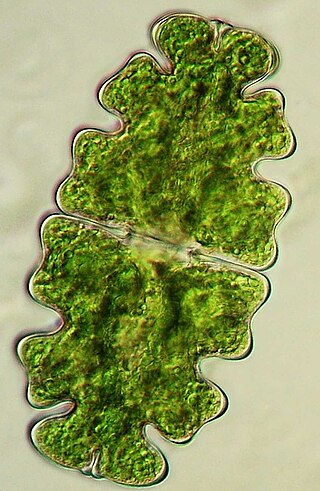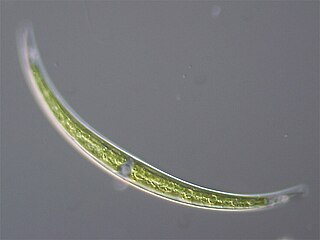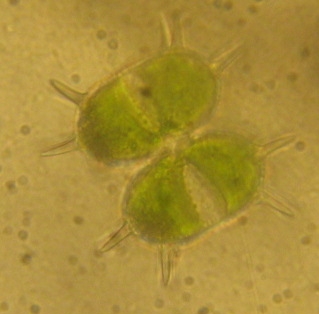
The Zygnematales, also called the Conjugatales, are an order of green algae, comprising several thousand different species in two families. The larger family Zygnemataceae, with well-known genera such as Zygnema and Spirogyra, includes members that grow as unbranched filaments, which grow longer through normal cell division. This group includes the desmids. Most members of both families live in freshwater, and form an important component of the algal scum that grows on or near plants and rocks.

Desmidiales, commonly called the desmids, are an order in the Charophyta, a division of green algae in which the land plants (Embryophyta) emerged. Desmids consist of single-celled microscopic green algae. Because desmids are highly symmetrical, attractive, and come in a diversity of forms, they are popular subjects for microscopists, both amateur and professional.

Euastrum oblongum is a species of desmid, in the family Desmidiaceae.

Micrasterias is a unicellular green alga of the order Desmidiales. Its species vary in size reaching up to hundreds of microns.

Chloromonas is a genus of green algae in the family Chlamydomonadaceae. It is closely related to the model green algae, Chlamydomonas, and traditionally has been distinguished mainly through the absence of a pyrenoid.

Lobomonas is a genus of green algae in the family Chlamydomonadaceae, found in freshwater habitats. Although it is widely distributed, it is a rare genus.

The Desmidiaceae are one of four families of charophyte green algae in the order Desmidiales (desmids).

Closterium is a genus of desmid, a group of charophyte green algae. It is placed in the family Closteriaceae. Species of Closterium are a common component of freshwater microalgae flora worldwide.

Cosmarium is a large genus of desmids (Desmidiaceae), a group of green algae closely related to the land plants (Embryophyta). Members of this genus are microscopic and found in freshwater habitats around the world.

Desmidium is a genus of green algae, specifically of the Desmidiaceae.
Spinoclosterium is a genus of green algae, specifically of the Closteriaceae. It is rare, but widely distributed in freshwater regions throughout the world.

Staurodesmus is a genus of green algae, specifically of the Desmidiaceae.

Triploceras is a genus of desmid in the family Desmidiaceae.

Xanthidium is a genus of green algae, specifically of the Desmidiaceae.

Zygnematophyceae is a class of green algae in the paraphylum streptophyte algae, also referred to as Charophyta, consisting of more than 4000 described species. The Zygnematophyceae are the sister clade of the Embryophyta.
Cosmarium tetragonum is a species of green algae in the family Desmidiaceae. It is a freshwater species with a worldwide distribution.

Spirotaenia is a genus of basal unicellular green algae that may be sister to the Chlorokybophyceae. It was previously considered to be part of the Zygnemataceae. It is sexually conjugating, a mode of reproduction that was previously only known in the Zygnemataceae/Mesotaeniaceae, the sister groups to the land plants. This is surprising, as Spirotaenia is much more basal. The conjugating process is substantially aberrant. Spirotaenia may actually be more than one distinct lineage which may not be closely related.

Cosmarium botrytis is a species of green algae in the family Desmidiaceae. It is a freshwater species with a worldwide distribution, and has been recorded from all continents.
Prescottiella is a genus of green algae in the family Desmidiaceae, containing the single species Prescottiella sudanensis. Originally classified as Micrasterias sudanensis in 1958, it was moved into its own genus by Carlos E. M. Bicudo in 1976, due to its asymmetric character. It is named after Gerald Webber Prescott, an American phycologist.

Xanthidium antilopaeum is a species of unicellular desmid in the family Desmidiaceae. It is a common, worldwide species found in acidic waters, particularly the edges of large ponds and lakes.

















